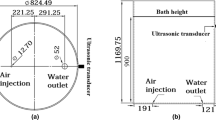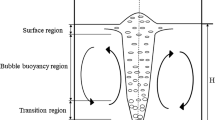Abstract
Differential and macroscopic models of argon–steel flows in ladle shroud have been developed. In this, argon–steel, two-phase flow phenomena have been formulated via a transient, three dimensional, turbulent flow model, based on the volume of fluid (VOF) calculation procedure. While realizable k–ε turbulence model has been applied to map turbulence, commercial, CFD software ANSYS-Fluent™ (Version 18), has been applied to carry out numerical calculations. Predictions from the model have been directly assessed against experimental measurements across the range of shroud dimensions and volumetric flow rates typically practiced in the industry. It is demonstrated that the two-phase turbulent flow model captures the general features of gas–liquid flows in ladle shroud providing estimates of free jet length and threshold gas flow rates (required to halt air ingression) which are in agreement with corresponding experimental measurements. In the absence of differential solutions, a macroscopic model has been worked out through dimensional analysis embodying multiple non-linear regression. It is shown that dimensionless free jet length in bloom and slab casting shrouds can be estimated reasonably accurately from the following correlation (in SI unit), viz.,
in which, Ljet is the free liquid jet length (m), QG is the gas flow rate (m3/s), QL is the liquid flow rate (m3/s), Dsh is shroud diameter (m), DCN is the collector nozzle diameter (m), σ is the interfacial tension (N/m), and ρG as well as ρL are respectively density of gas and liquid (kg/m3). It is demonstrated that the proposed correlation is consistent with the laws of physical modeling and leads to estimates that are in good agreement with predictions from the differential models, for both air-water as well as argon–steel systems. Numerical simulations as well as macroscopic modeling have indicated that thermo-physical properties of the gas–liquid system are important and exert some influences on the gas–liquid, two-phase, flow in ladle shrouds, albeit not to a large extent. Despite dissimilar thermo-physical properties, full scale water modeling appears to be sufficiently predictive and provides reasonable macroscopic descriptions of the two-phase flow phenomena in industrial ladle shroud systems.












Similar content being viewed by others
Notes
\( Fr_{\text{jet}} \left( { = \frac{{V_{\text{jet}}^{2} }}{{gD_{\text{CN}} }}} \right) \)) embodies jet velocity at the impinging point which, in the turbulent flow regime, is related to Ljet as: \( V_{\text{jet}} = \sqrt {V_{0}^{2} + 2gL_{\text{jet}} } . \) In any fixed physical system and a constant liquid flow rate, it follows from Eq. [10] that \( Q_{\text{G}} \alpha (L_{\text{jet}} )^{0.68} . \)
Abbreviations
- BCS:
-
Bloom casting shroud
- C :
-
Interface curvature
- C µ :
-
Empirical constant of the turbulence model
- C 2 :
-
Constant
- D CN :
-
Collector nozzle diameter
- \( D_{{{\text{CN}}_{\text{BCS}} }} \) :
-
Collector nozzle diameter of BCS
- \( D_{{{\text{CN}}_{\text{SCS}} }} \) :
-
Collector nozzle diameter of SCS
- D sh :
-
Shroud diameter
- \( D_{{{\text{sh}}_{\text{SCS}} }} \) :
-
Diameter of slab casting shroud
- \( D_{{{\text{sh}}_{\text{BCS}} }} \) :
-
Diameter of bloom casting shroud
- F σ :
-
Surface tension force per unit volume
- Fr jet :
-
Jet Froude number
- k :
-
Turbulent kinetic energy
- L sh :
-
Length of the shroud
- L jet :
-
Free liquid jet length
- L jet, BCS :
-
Free liquid jet length in BCS
- L jet,SCS :
-
Free liquid jet length in SCS
- P :
-
Dynamic pressure referenced to the local hydrostatic pressure
- Q G :
-
Gas flow rate
- Q L :
-
Liquid flow rate
- r :
-
Radial distance from the centerline of the shroud
- R sh :
-
Radius of the shroud
- SCS:
-
Slab casting shroud
- v i,m :
-
Time averaged, mixture velocities in the ith direction
- v j,m :
-
Time averaged, mixture velocities in jth direction
- \( \rho_{\text{L}} \) :
-
Density of liquid
- \( \rho_{\text{G}} \) :
-
Density of gas
- \( \sigma_{{}} \) :
-
Surface tension
- \( \alpha_{\text{G}} \) :
-
Critical gas flow rate
- λ :
-
Scaling factor
- \( \rho_{m} \) :
-
Mixture density
- \( \alpha_{1} \) :
-
Volume fraction of phase 1
- \( \alpha_{2} \) :
-
Volume fraction of phase 2
- \( \overset{\lower0.5em\hbox{$\smash{\scriptscriptstyle\frown}$}}{n} \) :
-
Normal vector to the interface
- \( \delta_{\text{s}} \) :
-
Dirac delta function
- \( \overrightarrow {{u_{\text{c}} }} \) :
-
Velocity is applied normal to the interface
- G k :
-
Generation of turbulence kinetic energy
- σ k :
-
Turbulent Prandtl numbers for k
- σ k :
-
Turbulent Prandtl numbers for ɛ
- \( \mu_{\text{t}} \) :
-
Turbulent viscosity
- \( \varepsilon \) :
-
Dissipation rate of turbulent kinetic energy
References
Prince K. Singh and Dipak Mazumdar, Metallurgical and Materials Trans B, 2018, Vol.48, pp.1945-1962.
Saikat Chatterjee, Donghui Li and Kinnor Chattpopadhyaya: Materials and Metallurgical Transactions B, 2018, 49B, pp 756-766.
D Mazumdar, Prince K Singh, Rohit K Tiwari: ISIJ International, 2018, Vol.58, pp. 1545–1547.
D.Mazumdar and J.W.Evans: Modeling of Steelmaking Processes, CRC Press, Boca Raton, 2009, pp. 217-220.
H.G. Weller: Technical Report TR/HGW/04, Open CFD Ltd., 2008.
Laihua Wang, Hae-Geon Lee, Peter Hayes, Steel Research, 1995, 66, pp.279-286.
L.T. Wang, Q.Y. Zhang, C.H. Deng and Z.B. Li, ISIJ Int., 2005, vol. 45, pp. 1138-44.
R.K. Tiwari: M.Tech Thesis, IIT Kanpur, India, 2018.
K. E. Wardle and H. G. Weller, International Journal of chemical Engineering,2013 Vol.2013, pp.1-13.
ANSYS® FLUENT, 18.0: Theory Guide, Chap. 4, December 2016.
A.K.Bin: Chemical Engineering Science, 1993, Vol.48, pp.3585-3630.
G.M.Evans, G.J.Jameson and C.D.Reilly: Experimental and Thermal Fluid Sciences, 1996, Vol.12, pp.142-149.
P.K. Singh: Unpublished Research, Indian Institute of Technology, Kanpur, 2018.
R.Guthrie: Engineering in Process Metallurgy, Clarendon Press, Oxford, UK,1989, pp.152-157.
MATLAB R2016a: Academic use, February 2016.
Acknowledgment
The authors gratefully acknowledge Mr. Rohit K. Tiwari, a former graduate student in the Process and Steel research Laboratory, IIT Kanpur for full scale computational results presented in Figure 11(a).
Author information
Authors and Affiliations
Corresponding author
Additional information
Publisher's Note
Springer Nature remains neutral with regard to jurisdictional claims in published maps and institutional affiliations.
Manuscript submitted October 13, 2018.
Rights and permissions
About this article
Cite this article
Singh, P.K., Mazumdar, D. Mathematical Modelling of Gas–Liquid, Two-Phase Flows in a Ladle Shroud. Metall Mater Trans B 50, 1091–1103 (2019). https://doi.org/10.1007/s11663-019-01526-y
Received:
Published:
Issue Date:
DOI: https://doi.org/10.1007/s11663-019-01526-y




